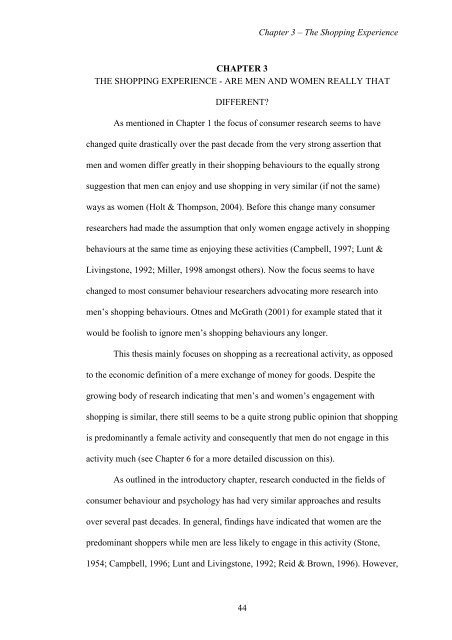CHAPTER 1 - University of Exeter
CHAPTER 1 - University of Exeter
CHAPTER 1 - University of Exeter
Create successful ePaper yourself
Turn your PDF publications into a flip-book with our unique Google optimized e-Paper software.
44<br />
Chapter 3 – The Shopping Experience<br />
<strong>CHAPTER</strong> 3<br />
THE SHOPPING EXPERIENCE - ARE MEN AND WOMEN REALLY THAT<br />
DIFFERENT?<br />
As mentioned in Chapter 1 the focus <strong>of</strong> consumer research seems to have<br />
changed quite drastically over the past decade from the very strong assertion that<br />
men and women differ greatly in their shopping behaviours to the equally strong<br />
suggestion that men can enjoy and use shopping in very similar (if not the same)<br />
ways as women (Holt & Thompson, 2004). Before this change many consumer<br />
researchers had made the assumption that only women engage actively in shopping<br />
behaviours at the same time as enjoying these activities (Campbell, 1997; Lunt &<br />
Livingstone, 1992; Miller, 1998 amongst others). Now the focus seems to have<br />
changed to most consumer behaviour researchers advocating more research into<br />
men’s shopping behaviours. Otnes and McGrath (2001) for example stated that it<br />
would be foolish to ignore men’s shopping behaviours any longer.<br />
This thesis mainly focuses on shopping as a recreational activity, as opposed<br />
to the economic definition <strong>of</strong> a mere exchange <strong>of</strong> money for goods. Despite the<br />
growing body <strong>of</strong> research indicating that men’s and women’s engagement with<br />
shopping is similar, there still seems to be a quite strong public opinion that shopping<br />
is predominantly a female activity and consequently that men do not engage in this<br />
activity much (see Chapter 6 for a more detailed discussion on this).<br />
As outlined in the introductory chapter, research conducted in the fields <strong>of</strong><br />
consumer behaviour and psychology has had very similar approaches and results<br />
over several past decades. In general, findings have indicated that women are the<br />
predominant shoppers while men are less likely to engage in this activity (Stone,<br />
1954; Campbell, 1996; Lunt and Livingstone, 1992; Reid & Brown, 1996). However,
















